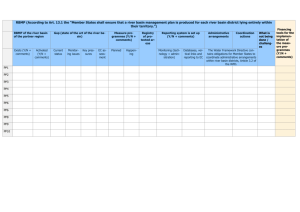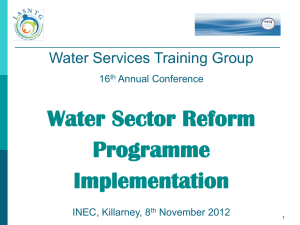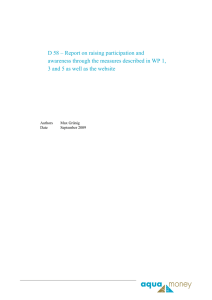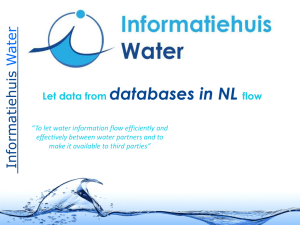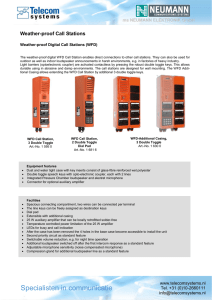Economic Value of Water in Research and Policy Roy Brouwer
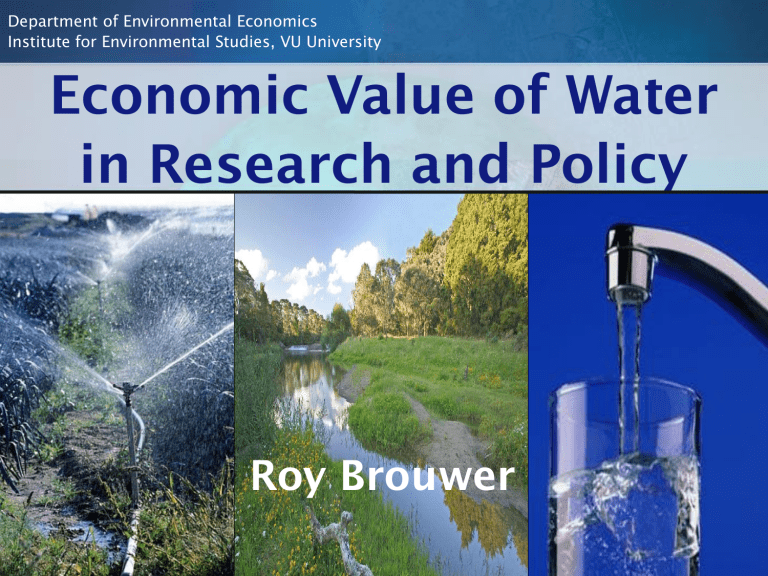
Department of Environmental Economics
Institute for Environmental Studies, VU University
Economic Value of Water in Research and Policy
Roy Brouwer
Economics in the Water Framework Directive
• Meeting the overall goal of good chemical and ecological status and sustainable water use through the application of:
• Economic principles
- Polluter Pays Principle
• Economic analysis
- River basin characteristics (Article 5)
- Cost-effective programme of measures (Article 11 & Annex III)
- Cost recovery water services (Article 9)
• Economic instruments
- Water pricing policies (Article 9)
Approach
3
What is the economic value of the WFD?
• Are the costs of implementation disproportionate?
• Not a standard economic concept, no standard guidelines
• No international benchmark available:
Reasons of overriding public importance in Habitat Directive (1992)
ALARA Principle: As Low As Reasonably Achievable (1993)
BATNEC in IPPC (1996): Best Available Techniques Not Entailing Excessive Costs
• Economic impacts (costs and benefits) & financial implications (increase prices, taxes, charges, fees etc.) across different basins, sectors, and stakeholders
• Uncertainty surrounding costs and benefits!
• Economic benefits of the WFD?
4
• Political decision!?
What is the economic value of water?
• Complex public good
• Critical environmental function (infinite value)
• Transboundary water flows
• Valuable feedback mechanisms (multifunctional, re-usable)
• Water has value but no price, or price ≠ true value
5
• High value if there is too little, negative value if there is too much water
Environmental and resource costs
WFD, Art. 9, Par.1:
‘ member states shall take account of the principle of recovery of the costs of water services, including environmental and resource costs , … , and in accordance in particular with the polluter pays principle ’
Economic Value?
www.aquamoney.org
(SSPI022723)
Increasing complexity and uncertainty
Uncertainty
Integration hydro-economics
International basin
Basin
Groups of water bodies
Water body
Complexity
Integrated modeling
• Abstractions of reality linking two realms of a system, i.c. economy and water
Economy transformations
Hydrology transformations
• Key to integrated modeling : economic functions of aquatic ecosystems
Consumption : drinking water, recreation etc.
Production : cooling, food and beverages, irrigation etc.
Water as a Source and Sink
WFD challenge
Economy transformations Hydrology transformations
Ecology
WFD challenge
Economy transformations Hydrology transformations
Ecology
Basic economic model
Constrained maximization (multiple objectives: economic output, water quality and ecological objectives)
Max Q t,p
=f t,p
(C t,p
,L t,p
,T(R t,p
)) subject to
C=C
L=L
R=R=water quantity/quality objectives where
Q : output (e.g. crop yield, electricity etc.)
C: capital
L: labour
T: transformation function
R: water resources (quantity, quality) t,p
: time and place (basin)
Groundwater
Classification integrated models
Top down
Economics Hydrology
Bottom up
WFD interventions
• Large scale
• Affecting other interrelated sectors (households, agriculture, industry)
• Price incentives in programs of measures (e.g. taxes, charges, marketable permits) to stimulate sustainable water use affecting market equilibrium prices
• HENCE
• More comprehensive economic modeling approaches needed
• Economy-wide modeling of the direct and indirect economic
WFD impacts
13
A different approach to integrated modeling
Modular approach
Economic model
Water & substance flow model
Water quality model
Economic scales
Micro Firm model
Meso Sector model Regional model
Macro National model
14
Change in
National
Income
Verandering in nationaal inkomen
0.05%
0.00%
-0.05%
-0.10%
-0.15%
-0.20%
-0.25%
-0.30%
-0.35%
2000
20% reductie
50% reductie
50% red. + derogatie
2005 2010 2015 2020 2025 2030
Change in
Water Quality
2000 emissies in 2015
Relative reduction in value added of industries: scenarios comparison
Basic metal industry
Chemical industry
Rubber- en plastics industry
Transport by water
Paper and -board industry
Transport equipment industry
Textiles, clothing and leather industry
Non-commercial services
Elektrotechnical industry
10% scenario
50% scenario
Transport by land
0.0
-
10.0
%
-
20.0
%
-
30.0
%
Applied
General Equilibrium Model
-
40.0
%
-
50.0
% 60.0
2%
5%
20%
11%
Distribution of direct and indirect costs:
3%
50% scenario
51%
Rijn West
Rijn Midden
Rijn Oost
Rijn Noord
Schelde
Maas
Eems
8%
Wetland ecosystem structure and processes
Functions
Hydrological
Flood water retention
Water recharge
Biogeochemical
-Nutrient retention & export
Ecological
-Wildlife habitat and nursery
-Landscape structural diversity
-Natural flood protection
Water supply
Habitat maintenance
Socio-economic benefits
-Improved water quality
Waste disposal
-Fishing
Wildfowl hunting
Recreational amenities
18
Open ocean $ 252/ha/yr
Coral reefs $ 675/ha/yr
Tropical forests $ 2,007/ha/yr
Grasslands
Wetlands
$ 232/ha/yr
$14,785/ha/yr
Lakes/rivers $ 8,498/ha/yr
AquaMoney
• Guidelines for water resource valuation in the WFD
• Move away from constant unit values
• Value functions
• Transfer testing
19
20
WFD water quality ladders
What are the non-market goods & services provided by the WFD amenable to robust economic valuation?
Source: Hime, Bateman et al. (2009)
Copyrights reserved.
Spatial value mapping in choice experiments
Valuation at individual water body level or river basin level?
How do we account for substitution effects?
Source: Brouwer, Martín-Ortega & Berbel, 2009
21
Economic value aggregation
Appropriate rules of aggregation using GIS
22
Source: Bateman et al., 2006
Conclusions
• Important role economics in WFD, but still much misunderstanding of the value added of economic tools and methods in WFD decision-making
• A variety of approaches used in a highly political-economic context
• Economic value of water evident, but not always evidenced
• Little empirical evidence available yet to produce ‘best practice recommendations’ in specific context of WFD
• Need for further development economic methods and tools to underpin the economic value of the WFD:
- Integrated models with more emphasis on wider economic impacts
- Experimental water pricing models
23
Program today
• Integrated hydro-economic modeling (Richard Tol)
- Integrated modeling nutrient abatement Baltic Sea - K. Hyytiainen
- Integrated modeling nutrient & sediment loads Tasmania – M. Kragt
• Water conflict & cooperation (Ines Dombrowski)
- Transboundary water sharing Volta basin – A. Bhaduri
- Wetlands decision rights Sweden - K. Elofsson
• Water resource valuation (Ian Bateman)
- Ecosystem valuation ecological restoration Danube basin – M. Getzner
- Water security and environmental flows South Europe – J. Martín-Ortega
• Water markets & pricing (John Rolfe)
- Two-parts instrument non-point source pollution Spain – R. Goetz
- Water quality trading US – G. Poe
24
Enjoy the Preconference!
Our sponsors
European Commission
DG Research
www.aquamoney.org
25

